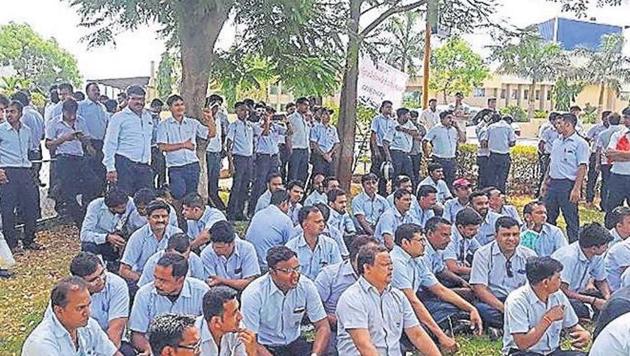Gujarat after Modi: Industry on auto-pilot but strains on job-creation front
Three years after Modi shifted to Delhi, the big-ticket industries in Gujarat are growing, but the traditional small and medium ones that accommodate most job seekers complain of neglect.
Things are on the edge in Halol, an industrial town in the heart of Gujarat, these days. On April 28, global automobile major General Motors (GM) abandoned its 172-acre manufacturing plant — a sprawling blue-and-white monument — and moved operations to Maharashtra.

The exit of Gujarat’s first automobile plant, set up in 1996 , is a disaster for its 1,100 employees. Six hundred of them have rejected the firm’s offer: relocation or retirement. Several of these workers HT met in Vadodara said they were too settled to move to Maharashtra and too old to find new factory work in Gujarat. “Our families have long moved here, our children go to Gujarati-medium schools in the area, this is the only community we will ever know,” said Jayanti Bhai, 32, who joined GM’s shop floor as a teenager.
“You don’t go looking for a new job at this age. The factories employ only 20-year-olds these days,” said Shailesh Parmar who is desperately giving job interviews. Hundreds of workers staged a silent hunger strike at the plant for weeks leading up to the plant closure. “From 4am when we get on the bus for Halol to 4pm when we leave the plant, none of us ate anything.” On May 4, GM offered a fresh separation packages to the workers.
The workers’ plight highlights the challenges industry is facing in Gujarat. Three years after Narendra Modi shifted to Delhi as PM, the state continues to put big companies at the centre of its industrial roadmap, even as their ability to create and retain jobs is under strain. According to the state industries department, Gujarat’s automobile sector has received $2 billion in investment from Ford, Suzuki Motors, Honda and Hero MotoCorp. Additional investment of $3.2 billion is committed to this sector by 2020. And the number of jobs created by the sector? The employment department put it at “more than 1.35 lakh persons”.
“Capital-intensive industries in Gujarat are growing. Labour-intensive industries like textile, readymade garments and leather are not,” said Devendra Pant, chief economist at India Ratings, a market analytics agency. “But that is true of any part of India. We have an employment problem. Whatever you do, manufacturing cannot create jobs for everyone,” said Laveesh Bhandari, head of economic think-tank Indicus Foundation.
- The Gross State Domestic Product (GSDP) of Gujarat in 2015-16 was recorded as 6.7%, lowest in past 10 years.
- The manufacturing sector’s contribution to Gujarat’s GDP is 31.6%, according to latest estimates.
- Total number of working factories in the state increased from 18,880 in 2001 to 30,192 in 2014.
- Locals form 92% of private sector workforce in Gujarat. Percentage of local employment in automobile sector ranges between 82% and 85%.
- Gujarat is ranked 15 in the share of wages in the net value added in the industrial sector.
Even after Modi’s departure from Gujarat, industry continues to grow in the state. Gujarat’s manufacturing sector grew at 11% between 2011-12 and 2015-16, compared to a 6.1% growth for India, according to Gujarat Socio Economic Review 2016-17. “That’s because of the nature of industry in Gujarat — chemicals, pharma – which is growing steadily. A good set of firms have been able to evolve over a period of time. Moreover, the lower-level bureaucracy of Gujarat is less intrusive than in other places,” Bhandari said.
Government insiders liken the situation to something that is on auto-pilot. Modi or no Modi, industry enjoys a momentum that the change of guard in the state hasn’t impeded. However, the growth doesn’t translate into employment. Big-ticket industries – chemicals, petrochemicals, automobiles, pharmaceuticals — get the best deal (taxes, land, water, power) from the government. But the state’s traditional network of small and medium industries — diamond, textile, leather, ceramics – that accommodate most job-seekers often complain of neglect.
The Union labour ministry’s employment survey for 2016 says Gujarat had the lowest unemployment rate among all states in India. Yet, the state’s employment exchanges had recorded 6.11 lakh job-seekers on their live registers as of October 31, 2016.
Over the last three years, youth across Gujarat have hit the streets demanding jobs and quota. Fourteen young Patidars lost their lives, 700 OBC youths detained for locking down factories, and one CM – Anandiben Patel — has had to step down.
“More than six lakh jobs have been created in the industrial sector between 2014 and 2017,” said Rajeev Gupta, principal secretary, department of labour and employment. Half of these jobs came up in industrial units with fewer than 10 employees. According to data shared by the industries department, the state has 6,240 large industries and 6.3 lakh MSMEs; the former employs 11 lakh people and the latter 46 lakh. “The large, small and medium industries sector in Gujarat is facing a crisis, partly because they are dependent on the international market. Over the last decade, more than 10% of this industry has been declared sick,” said Ghanshyam Shah, a Gujarat-based political scientist.
Close to 20,500 MSME units reported sick in 2013, the number more than doubled to 42,500 in 2016. A quarter of the 600-odd units in Morbi, the biggest ceramic cluster in India, shut down during the note-ban drive.
This is grim news for many like Dharmendra Singh Vaghela of Sanand. The ITI graduate has given three interviews at an automobile factory. “Each time they said they will call back. They never do.”
(This is the third part of HT’s four-part series)





